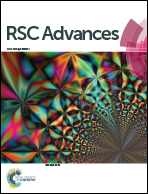Binder-free Sn–Si heterostructure films for high capacity Li-ion batteries
Abstract
This study fabricated and demonstrated a functional, stable electrode structure for a high capacity Li-ion battery (LIB) anode. Effective performance is assessed in terms of reversible lithiation for a significant number of charge–discharge cycles to 80% of initial capacity. The materials selected for this study are silicon and tin and are co-deposited using an advanced manufacturing technique (plasma-enhanced chemical vapour deposition), shown to be a scalable process that can facilitate film growth on 3D substrates. Uniform and hybrid crystalline–amorphous Si nanowire (SiNW) growth is achieved via a vapour–liquid–solid mechanism using a Sn metal catalyst. SiNWs of less than 300 nm diameter are known to be less susceptible to fracture and when grown this way have direct electrical conductivity to the current collector, with sufficient room for expansion. Electrochemical characterisation shows stable cycling at capacities of 1400 mA h g−1 (>4 × the capacity limit of graphite). This hybrid system demonstrates promising electrochemical performance, can be grown at large scale and has also been successfully grown on flexible carbon paper current collectors. These findings will have impact on the development of flexible batteries and wearable energy storage.



 Please wait while we load your content...
Please wait while we load your content...